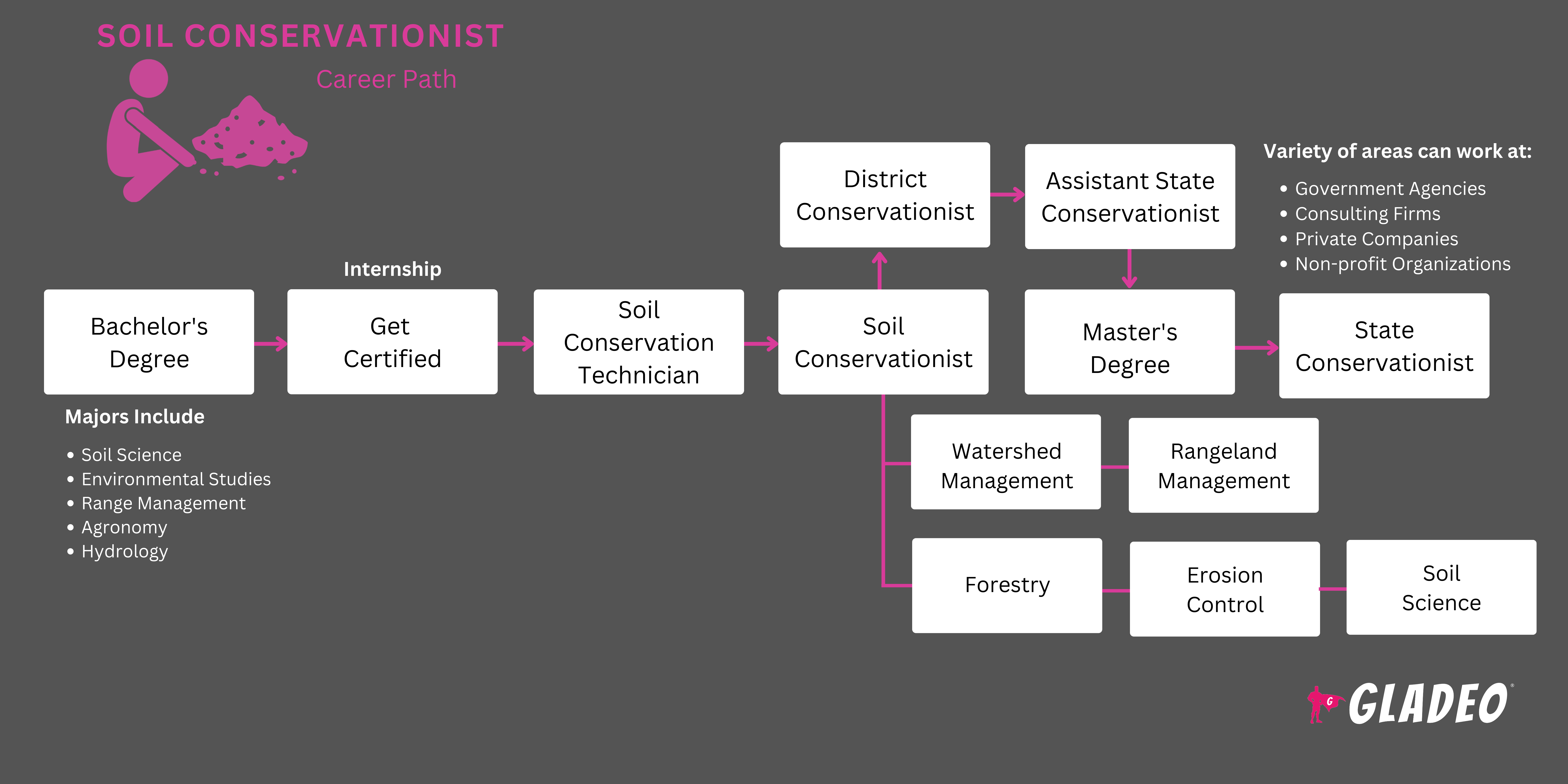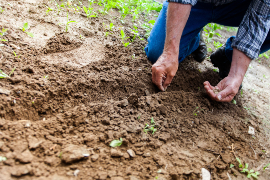Spotlights
Conservation Scientists, Conservationist, Environmental Analyst, Environmental Quality Scientists, Erosion Control Specialists, Land Reclamation Specialists, Land Resource Specialists, Research Soil Scientists, Resource Conservation Specialist, Resource Conservationist, Soil Conservationists
The world has a lot of mouths to feed, with over 8 billion people plus so many animals it’s impossible to count them all. Combined, we’re putting a strain on one of the planet’s most valuable resources—soil!
71% of the Earth’s surface is water, leaving just 29% for land. Of that land, only ~10-11% is arable soil that’s suitable for growing crops. Meanwhile, other types of soil play vital roles in maintaining natural ecosystems, or in supporting urban structures.
Soil is fundamental to the continued existence of life as we know it. It’s so important, we now rely on dedicated Soil Conservationists to safeguard this precious resource. They assess the health and quality of soils, design measures to prevent erosion, and promote practices that enhance soil vitality.
Their work helps ensure the fertility of the ground for agricultural productivity. It also preserves the natural balance of ecosystems, prevents water pollution, and supports biodiversity!
- Getting to spend time peacefully working outdoors
- Supporting an invaluable resource needed to feed the population
- Helping the environment and supporting wildlife habitats
Lịch làm việc
- Soil Conservationists work full-time jobs. Travel for fieldwork and site visits to farms, forests, or other sites may be needed. There could be exposure to inclement weather or hazards such as pests or chemicals.
Nhiệm vụ tiêu biểu
- Examine sites to assess topographical properties, such as soil types and qualities
- Meet and work with farmers and landowners to draft conservation plans
- Collaborate with applicable local, state, and federal agencies
- Create suitable soil conservation practices for sites
- Practices may include contour plowing, strip cropping, covering crops, terracing, crop rotation, planting trees and shrubs, creating tree windbreaks, no-till farming, installing ponds and grass waterways, subsoiling, mulching, erosion control blankets, managed grazing, etc.
- Create a database of soil types, erosion data, and actions taken
- Suggest amendments to improve soil health
- Monitor the effectiveness of implemented practices; gauge the impacts on soil health
- Work with engineers and hydrologists to ensure that soil conservation efforts align with water conservation needs
- Monitor construction practices and offer guidance on erosion control
- Advise on water quality and conservation issues such as wetlands restoration
Trách nhiệm bổ sung
- Look for organizations to establish mutually-beneficial partnerships
- Write or assist with grant proposals to seek project funding
- Provide education and training to agencies and institutions, as needed
- Keep up to date on trends and best practices
- Participate in professional organization events, such as workshops and conferences
- Draft technical reports outlining findings and recommendations
- Train and mentor new conservationists
Kỹ năng mềm
- Chính xác
- Phân tích
- Chú ý đến chi tiết
- Kỹ năng giao tiếp
- Continuous learning
- Dịch vụ khách hàng
- Định hướng chi tiết
- Độc lập
- Sáng kiến
- Phương pháp
- Giám sát
- Tổ chức
- Kiên nhẫn
- Đáng tin cậy
- Lập kế hoạch
- Phán đoán và ra quyết định đúng đắn
- Quản lý thời gian
Kỹ năng kỹ thuật
- Knowledge of soil science, including soil profiles and physics
- Basic chemistry and biology
- Hydrology, including water movement, water quality, and the ways to conserve and improve water resources
- Agronomy/crop science, including types of crops, growth cycles, and effects on soils
- Erosion control techniques, like terracing, strip cropping, contour plowing, cover crops, etc.
- Knowledge of agricultural equipment and machines
- Research and measurement-taking skills; basic land survey tools
- Databases and analytics programs for soil health information
- Land-use planning
- Hệ thống thông tin địa lý (GIS)
- Remote sensing using satellite imagery or aerial photography
- Software for soil modeling and data analysis
- Conservation planning; wetlands preservation; environmental impact assessment methods
- Knowledge of governmental agencies, policies, and regulations
- Bằng lái xe hợp lệ (đối với một số công việc)
- Private industries
- Conservation organizations
- Cơ quan chính phủ
- Colleges, universities, and other research facilities
Much rides on the important work of Soil Conservationists, who bear a lot of responsibility to ensure our valuable soil resources are protected and used efficiently!
They have to be able to conduct thorough soil surveys and studies, develop feasible conservation plans, reduce erosion, and help with proper water drainage and irrigation. Oversights and errors can lead to mistakes that cost farmers and businesses money and may be harmful to the environment and wildlife habitats.
Soil conservation is in the spotlight because of increasing awareness of the pivotal role soil plays in our climate, food security, and ecosystem health.
Regenerative agriculture is a trend that goes beyond sustainable farming by actively improving the health and vitality of soils. This includes practices like no-till or reduced tillage, which minimizes soil disturbance; cover cropping; and crop rotation and diversification. These techniques enhance soil health and boost its ability to capture carbon from the atmosphere.
Another trend is the nurturing of soil microbiomes, in which microorganisms promote soil health and plant growth, reducing the need for chemical fertilizers and pesticides. In addition, digital agriculture technologies such as drones, sensors, and machine learning algorithms are being used to monitor soil health, predict erosion patterns, and optimize irrigation.
Soil Conservationists may have always loved to work outside in natural settings. They could have grown up in rural settings, such as around farms, fields, or forests. They care about wildlife and the environment, and are patient and meticulous—traits that could have come from any number of childhood experiences!
- Soil Conservationists usually have at least a bachelor’s degree. There is no single required major. Some major in plant/crop or soil science, others in horticulture, chemistry, or even biology
- Các lớp phổ biến có thể bao gồm:
- Agronomy and crop science
- Climatology and soil-climate interactions
- Conservation planning and management
- Ecology and environmental science
- Environmental law and policy
- Erosion and sediment control
- Geographic information systems and remote sensing
- Hydrology and watershed management
- Land reclamation and remediation
- Quy hoạch sử dụng đất
- Soil chemistry
- Statistical methods
- Soil conservation workshop
- Learners who want to beef up their education in a specific area can consider ad hoc online courses from Udemy, HortCourses, Skillshare, and other sites
- Optional certifications such as Certified Professional Soil Scientist and Associate Professional Soil Scientist from the Soil Science Society of America can boost your credentials
- Look for a program that offers enough specialized courses related to soil and soil conservation
- Xem xét chi phí học phí, giảm giá và các cơ hội học bổng địa phương (ngoài viện trợ liên bang)
- Hãy suy nghĩ về lịch trình và sự linh hoạt của bạn, khi quyết định nên đăng ký vào một chương trình trong khuôn viên trường, trực tuyến hay kết hợp
- Check out the academic and work backgrounds of faculty members. Review their current research and writings, and see awards they may have received or accomplishments they are known for
- Take a look at graduation rates, job placement statistics, and what alumni are up to
- In high school, stock up on botany, biology, chemistry, physics, statistics, and agriculture classes. Try to learn what you can about agronomy, crop science, climatology, environmental science, hydrology, land reclamation, soil chemistry, and microbiology
- Sign up if your school features a gardening or agricultural program, or start your own garden at home or at a community plot
- Look for internships, cooperative experiences, part-time jobs, or volunteer projects while in college. You could work at a plant nursery, on a farm, or for a local college
- The Farm Production and Conservation Business Center “offers different pathway opportunities for students and recent graduates to work in the agricultural, science, technology, math, environmental, management, business, and many other fields”
- Take part in student chapters of the Soil and Water Conservation Society (SWCS)
- Request an informational interview with a working Soil Conservationist in your community
- Check out the career profiles of successful members of the SWCS community
- Apply for related part-time jobs, volunteer activities, cooperative educational opportunities, or internships
- Study soil conservation-related articles and videos. Get in the habit of reading technical materials such as scientific papers, and not just blogs
- Consider taking ad hoc online courses from Udemy, HortCourses, Skillshare, and other sites
- Soạn thảo một sơ yếu lý lịch làm việc để theo dõi công việc và thành tích học tập của bạn
- Join professional organizations to learn, share, make friends, and grow your network (see our list of Resources > Websites)
- Theo dõi tên và thông tin liên lạc của những người có thể làm người tham khảo công việc sau này

- Check out job portals like Indeed.com, LinkedIn, Glassdoor, Monster, CareerBuilder, SimplyHired, ZipRecruiter, USAJOBS, AgCareers.com
- Note, the Inflation Reduction Act helped create more conservation job opportunities so keep an eye on the Natural Resources Conservation Service’s career page
- Ghi chú những từ khóa quan trọng trong bài đăng tuyển dụng. Đưa chúng vào sơ yếu lý lịch và thư xin việc của bạn.
- Apply for soil conservation technician jobs where you can get experience helping conservationists with data collection, surveying and design activities, staking, field investigations, inspections, public outreach, and other tasks
- Check out Soil Conservationist resume examples and search online for sample interview questions
- Nói với mọi người trong mạng lưới chuyên nghiệp của bạn rằng bạn đang tìm kiếm việc làm
- Hãy cân nhắc việc chuyển đến nơi có nhiều việc làm hơn
- The states with the highest employment numbers for Conservation Scientists are Texas, California, Colorado, Mississippi, and Pennsylvania
- The states with the highest concentration of jobs are Montana, Alaska, South Dakota, Mississippi, and North Dakota
- The states that pay the most for these jobs are Washington D.C., Hawaii, Maryland, Minnesota, and Nevada
- Hỏi các giáo sư đại học, cựu giám sát viên và / hoặc đồng nghiệp của bạn nếu họ sẵn sàng phục vụ như là tài liệu tham khảo cá nhân. Không cung cấp thông tin liên hệ cá nhân của họ mà không có sự cho phép trước
- Thực hiện các cuộc phỏng vấn giả với trung tâm hướng nghiệp của trường hoặc với bạn bè của bạn, vì vậy bạn sẽ cảm thấy sẵn sàng và thoải mái hơn trong các cuộc phỏng vấn thực tế
- Ăn mặc phù hợp cho các cuộc phỏng vấn và thể hiện sự nhiệt tình và kiến thức của bạn về lĩnh vực này
- Hãy cho cấp trên biết bạn muốn đảm nhận thêm trách nhiệm và sẵn sàng tham gia đào tạo bổ sung nếu cần. Hãy đảm bảo bạn hiểu rõ các tiêu chí thăng chức.
- Document your successes and contributions!
- Be proactive. Volunteer for challenging projects or tasks that might be outside your regular duties. Identify areas where improvements can be made in current conservation practices and suggest solutions
- Knock out a specialty certification such as Certified Professional Soil Scientist or Associate Professional Soil Scientist from the Soil Science Society of America
- Consider completing a master’s or PhD, if warranted
- Develop and refine your technical skills related to soil analysis, erosion control, conservation planning, etc.
- Keep up with environmental trends and challenges that impact soil. Learn about emerging technologies through continuing education courses, workshops, or conferences
- Stay very familiar with local, state, and federal regulations and policies regarding soil conservation
- Thể hiện tính độc lập, chính trực và khả năng lãnh đạo. Trao đổi thông tin và lời khuyên với đồng nghiệp. Hướng dẫn và cố vấn cho người khác
- Cộng tác hiệu quả với các thành viên trong nhóm và phát triển mối quan hệ bền chặt với các cơ quan môi trường địa phương
- Publish papers in high-impact journals like the Journal of Soil and Water Conservation to demonstrate your research skills and to get your work seen by a wider audience
- Hãy hỏi xem có kỹ năng hoặc hệ thống thủy canh chuyên biệt nào mà bạn có thể học để mang lại lợi ích cho doanh nghiệp hay không. Hãy cho họ biết bạn sẵn sàng tham gia đào tạo và hỏi xem họ có thể hỗ trợ học phí không.
- Luôn thực hiện các quy trình an toàn tốt và đeo găng tay hoặc kính bảo vệ mắt khi cần thiết
- Engage with professional hydroponics organizations like the Soil Science Society of America. Attend meetings and events to learn and make connections
- Khi thời điểm thích hợp đến, hãy cân nhắc nộp đơn xin việc vào những công ty lớn hơn có thể cung cấp mức lương cao hơn hoặc cơ hội thăng tiến tốt hơn
Các trang web
- AgCareers.com
- Liên đoàn Cục Nông nghiệp Hoa Kỳ
- Hiệp hội Khoa học Làm vườn Hoa Kỳ
- Hiệp hội Vi sinh vật học Hoa Kỳ
- Hiệp hội Nông học Hoa Kỳ
- Hội Thực vật học Hoa Kỳ
- Trung tâm Kiểm soát Dịch bệnh
- Hiệp hội Khoa học Cây trồng Hoa Kỳ
- Bộ Nông nghiệp
- Dow AgroScience
- Hiệp hội Sinh thái Hoa Kỳ
- Hiệp hội côn trùng học Hoa Kỳ
- Cơ quan bảo vệ môi trường
- Farm Production and Conservation Business Center
- Dịch vụ Lâm nghiệp
- Hiệp hội kiểm soát xói mòn quốc tế
- Journal of Soil and Water Conservation
- Hội Nấm học Hoa Kỳ
- National Alliance of Independent Crop Consultants
- Hiệp hội Sức khỏe Môi trường Quốc gia
- National Farmers Organization
- Viện Nông nghiệp và Thực phẩm Quốc gia
- Viện Y tế Quốc gia
- Dịch vụ Công viên Quốc gia
- Natural Resources Conservation Service
- National Sustainable Agriculture Coalition
- Bảo tồn thiên nhiên
- Hiệp hội Thực phẩm Thực vật
- Hội các nhà nghiên cứu giun tròn
- Soil and Water Conservation Society
- Hiệp hội Khoa học Đất Hoa Kỳ
- Syngenta
- Viện Hàn lâm Khoa học Quốc gia
- Cục Quản lý Thực phẩm và Dược phẩm Hoa Kỳ
- Dịch vụ Kiểm tra Sức khỏe Động thực vật của USDA
- Weed Science Society of America
Sách vở
- Below the Surface: Dive Deep into Soil Science and Discover the Foundations of Regenerative Agriculture, by James Mckenzie
- Dirt to Soil: One Family’s Journey into Regenerative Agriculture, by Gabe Brown
- Sustainable Agriculture and Soil Conservation Hardcover, by Mirko Castellini (Editor), et. al.
The Bureau of Labor Statistics projects a 4% rise in jobs for conservationists in general over the next decade. However, that figure may grow thanks to the Inflation Reduction Act which is helping to create more conservation programs—and thus more job opportunities, for Soil Conservationists and other fields.
If you want to explore a few related types of jobs, check out some of the below options:
- Kỹ thuật viên Khoa học Nông nghiệp và Thực phẩm
- Nhà nông học
- Nhà sinh thái học
- Nhà khoa học môi trường
- Nhân viên bảo trì mặt đất
- Nhà làm vườn
- Người làm vườn
- Nhà tự nhiên học
- Xử lý thuốc trừ sâu
- Nhà sinh học thực vật
- Quản lý vườn nho
Nguồn cấp tin tức

Công việc nổi bật

Các khóa học và công cụ trực tuyến

Kỳ vọng về mức lương hàng năm
New workers start around $87K. Median pay is $104K per year. Highly experienced workers can earn around $140K.
Kỳ vọng về mức lương hàng năm
New workers start around $59K. Median pay is $80K per year. Highly experienced workers can earn around $109K.
Kỳ vọng về mức lương hàng năm
New workers start around $51K. Median pay is $77K per year. Highly experienced workers can earn around $97K.
Kỳ vọng về mức lương hàng năm
New workers start around $67K. Median pay is $75K per year. Highly experienced workers can earn around $109K.







